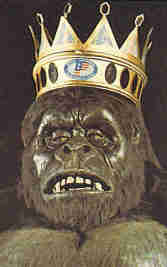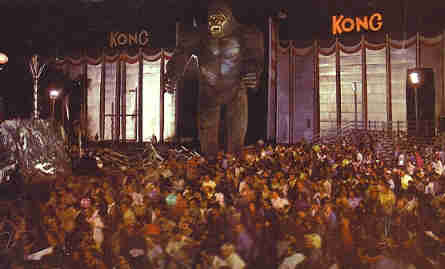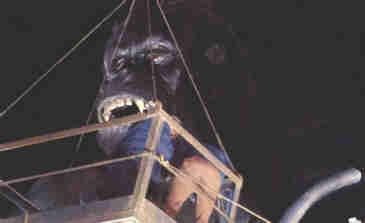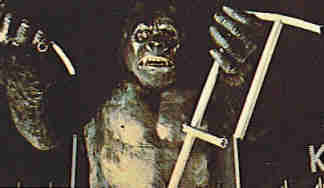

 Robot Kong!
Robot Kong!| The King Kong robot was the greatest, most audaciously daring and deviously deceptive ad campaign ever created to sell a motion picture -- comparable to William Castle's famous "Tingler" campaign. |
 From the moment he announced plans to
remake King Kong until it hit theatres more than a year later, Dino De
Laurentiis's PR machine hammered home one message: Audiences were
going to see a 40-foot tall robot Kong.
From the moment he announced plans to
remake King Kong until it hit theatres more than a year later, Dino De
Laurentiis's PR machine hammered home one message: Audiences were
going to see a 40-foot tall robot Kong. | It was the easiest lie to sell, because everyone wanted to believe in a 40-foot robot Kong. They largely fooled themselves. |
 Obviously we don't know for sure what De Laurentiis
was thinking when he came up with the impossible idea of building a
40-foot robot. But the bottom line is just that -- it was impossible. For all the
rumours of delays, it is clear in hindsight that De Laurentiis knew
very well that the robot could not be used to make his movie and from
the start filming concentrated on Rick Baker in his gorilla costume
with its ground-breaking animatronic mask. Stories about the
filmmakers only having the arms completed were confused reports arising
from the fact that they really did use two full sized robot arms
(technological marvels in their own right) for the close-ups of
Dwan in Kong's hands. (Real delays came about because of
technical problems with these arms.)
Obviously we don't know for sure what De Laurentiis
was thinking when he came up with the impossible idea of building a
40-foot robot. But the bottom line is just that -- it was impossible. For all the
rumours of delays, it is clear in hindsight that De Laurentiis knew
very well that the robot could not be used to make his movie and from
the start filming concentrated on Rick Baker in his gorilla costume
with its ground-breaking animatronic mask. Stories about the
filmmakers only having the arms completed were confused reports arising
from the fact that they really did use two full sized robot arms
(technological marvels in their own right) for the close-ups of
Dwan in Kong's hands. (Real delays came about because of
technical problems with these arms.) The second problem was this. The ultimate goal
in a movie like King Kong is to convince the audience that they are really watching a 40-foot gorilla on
screen. Obviously this goal is impossible to achieve -- the
audience knows there is no such thing as a 40-foot gorilla. But
De Laurentiis realized that he could do the next best thing -- he could
convince the audience that they were seeing, not a 40-foot gorilla, but
a 40-foot robot gorilla.
Thus, he killed two birds with one stone, solving both problems at
once. All he had to do was lie.
The second problem was this. The ultimate goal
in a movie like King Kong is to convince the audience that they are really watching a 40-foot gorilla on
screen. Obviously this goal is impossible to achieve -- the
audience knows there is no such thing as a 40-foot gorilla. But
De Laurentiis realized that he could do the next best thing -- he could
convince the audience that they were seeing, not a 40-foot gorilla, but
a 40-foot robot gorilla.
Thus, he killed two birds with one stone, solving both problems at
once. All he had to do was lie.| It seemed a small step from Abe Lincoln to a 40-foot Kong. |
 To a modern audience, it may seem hard to understand
how audiences could have been fooled so easily, when, for example, the British magazine Look-In described Robot Kong this way: "In fact, today's Kong is an ingenious forty-foot mechanical monster, weighing six and a half tons. Able to cover fifteen feet in one stride, he's electronically controlled by a complex hydraulic valve system that can roll his eyes and give sixteen separate movements to his hands." After all, to this day, no one has ever managed to create a two-footed robot capable of walking, let alone a 40-foot tall one! Forget C-3P0, it simply hasn't been done and it certainly could never have been accomplished in 1976.
To a modern audience, it may seem hard to understand
how audiences could have been fooled so easily, when, for example, the British magazine Look-In described Robot Kong this way: "In fact, today's Kong is an ingenious forty-foot mechanical monster, weighing six and a half tons. Able to cover fifteen feet in one stride, he's electronically controlled by a complex hydraulic valve system that can roll his eyes and give sixteen separate movements to his hands." After all, to this day, no one has ever managed to create a two-footed robot capable of walking, let alone a 40-foot tall one! Forget C-3P0, it simply hasn't been done and it certainly could never have been accomplished in 1976. | It is clear reading reviews written at the time that critics really thought a substantial portion of the movie they watched had used the 40-foot robot. |
 Of course, De Laurentiis knew he could only carry a
lie like that so far. He had to have the robot put in a brief
appearance in the movie, so he could claim that he hadn't lied, he had
just exaggerated. At the same time, he used the public filming of the
Shea Stadium scene -- where the robot was unveiled in front of a live audience -- as a chance to bolster his lie. Now reporters
were certain they were going to see a 40-foot Kong robot in the movie
--
because they had seen the beast with their own eyes!
Of course, De Laurentiis knew he could only carry a
lie like that so far. He had to have the robot put in a brief
appearance in the movie, so he could claim that he hadn't lied, he had
just exaggerated. At the same time, he used the public filming of the
Shea Stadium scene -- where the robot was unveiled in front of a live audience -- as a chance to bolster his lie. Now reporters
were certain they were going to see a 40-foot Kong robot in the movie
--
because they had seen the beast with their own eyes! between Rick Baker's costume and Robot Kong -- even
as the examples they cited proved that they didn't have a clue.
None of them guessed that the robot only appeared in a few brief
glimpses.
between Rick Baker's costume and Robot Kong -- even
as the examples they cited proved that they didn't have a clue.
None of them guessed that the robot only appeared in a few brief
glimpses. | Even as the audience knew they were
watching an illusion, they didn't
realize how great that illusion really was. |
 seeing
an
illusion. Knowing it is an effect, they look for the tell-tale
clues that give the illusion away: the zipper down the back, the nearly
invisible wire. In the case of King Kong '76, most of the
effects involved illusions of scale -- making small models seem like
much larger objects. Although there was no way to convince the
audience
that they were watching a real 40-foot gorilla, by convincing them
that they were watching a real 40-foot robot, they were fooled into
accepting the miniature sets as full sized buildings and trees.
Even as the audience knew they were watching an illusion, they didn't
realize how great that illusion really was.
seeing
an
illusion. Knowing it is an effect, they look for the tell-tale
clues that give the illusion away: the zipper down the back, the nearly
invisible wire. In the case of King Kong '76, most of the
effects involved illusions of scale -- making small models seem like
much larger objects. Although there was no way to convince the
audience
that they were watching a real 40-foot gorilla, by convincing them
that they were watching a real 40-foot robot, they were fooled into
accepting the miniature sets as full sized buildings and trees.
Even as the audience knew they were watching an illusion, they didn't
realize how great that illusion really was.
